Abstract
Interleukin 2 (IL-2) mediates the regression of metastatic cancer but clinical use has been limited due to associated toxicities. Tumor necrosis factor (TNF) is an important mediator of IL-2 toxicity and may have a limited role in IL-2 antitumor efficacy. Because pentoxifylline (PTXF) inhibits TNF production, we hypothesized that PTXF would ameliorate IL-2 toxicity without compromising antitumor efficacy. Four groups of female C57BL/6 mice with pulmonary metastases from a 3-methylcholanthrene-induced fibrosarcoma (MCA-105) and four groups of nontumored mice were treated every 6 h for 4 d by intraperitoneal injections of either IL-2 alone, IL-2 and PTXF, PTXF alone, or equal volumes of saline. Upon completion of therapy, we found that PTXF suppressed many of the IL-2-induced effects including TNF production, lymphocytic infiltration of multiple organs, multiple organ edema, hepatic dysfunction, leukopenia, and thrombocytopenia. Tumor response was determined 21 d after cessation of therapy by quantitating the number and surface area of pulmonary metastases. PTXF preserved antitumor efficacy while reducing the morbidity and mortality caused by IL-2 treatment. These data strongly support the use of PTXF in extending the therapeutic index of IL-2 in the treatment of cancer.
Full text
PDF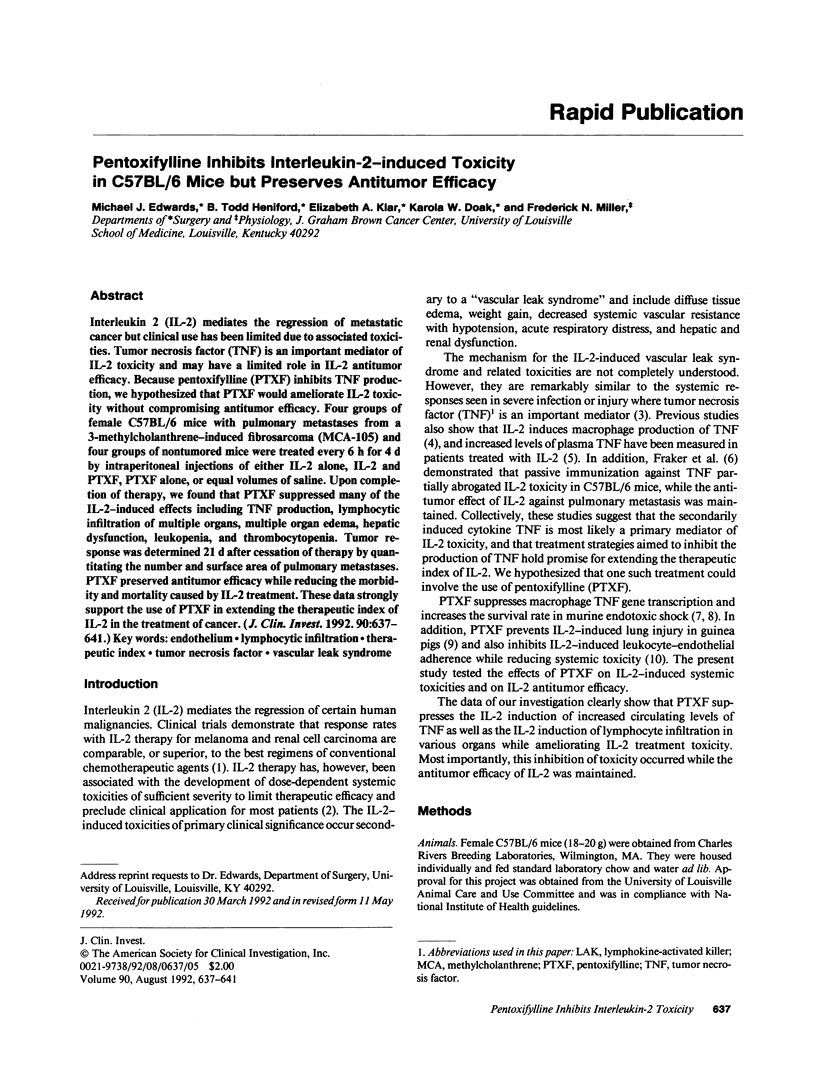
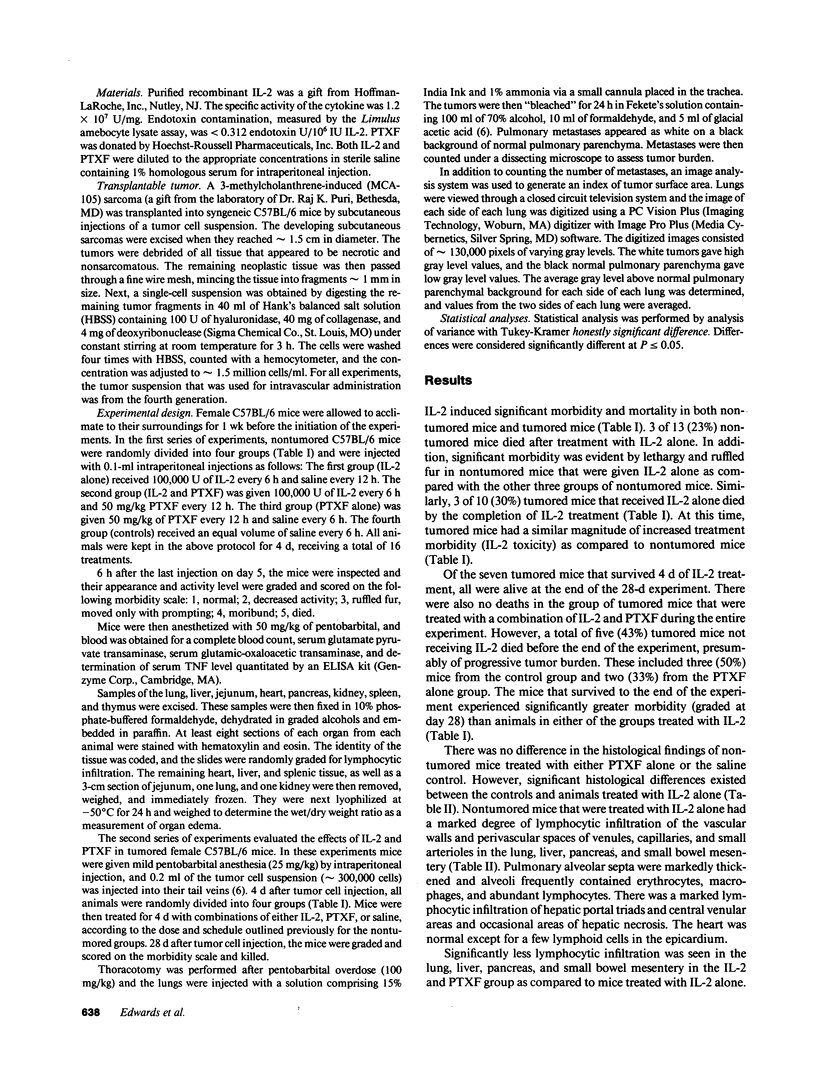
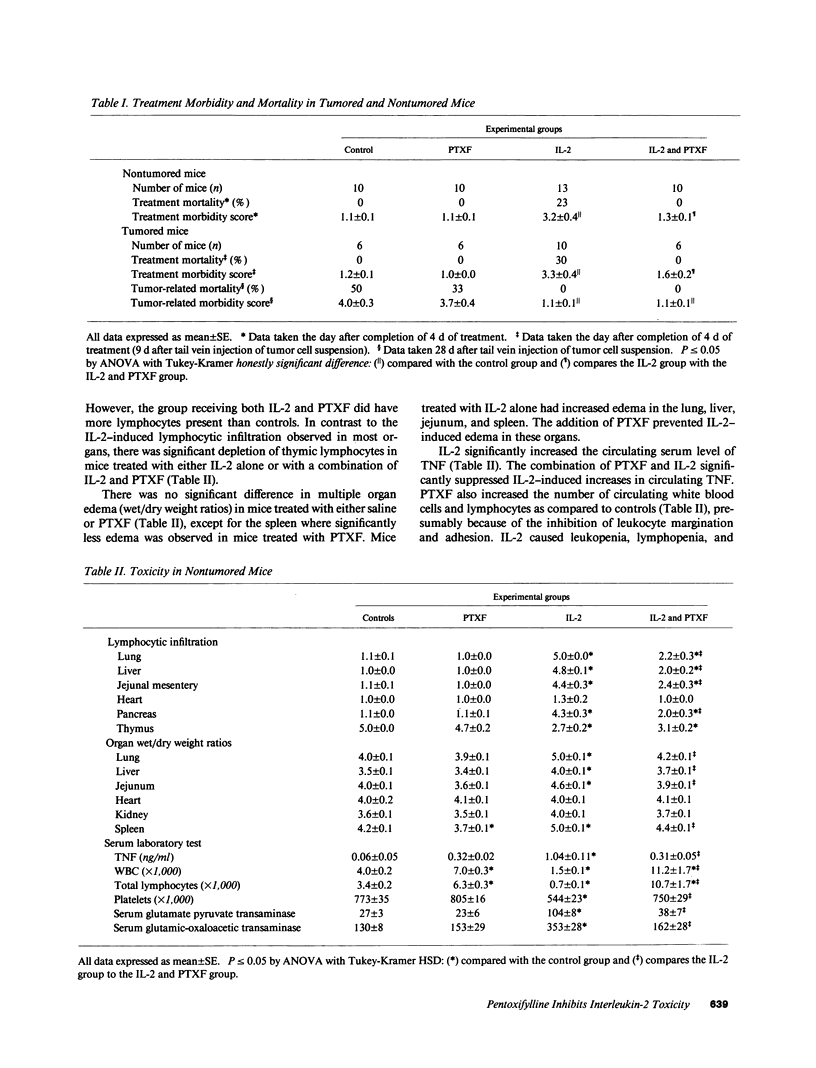
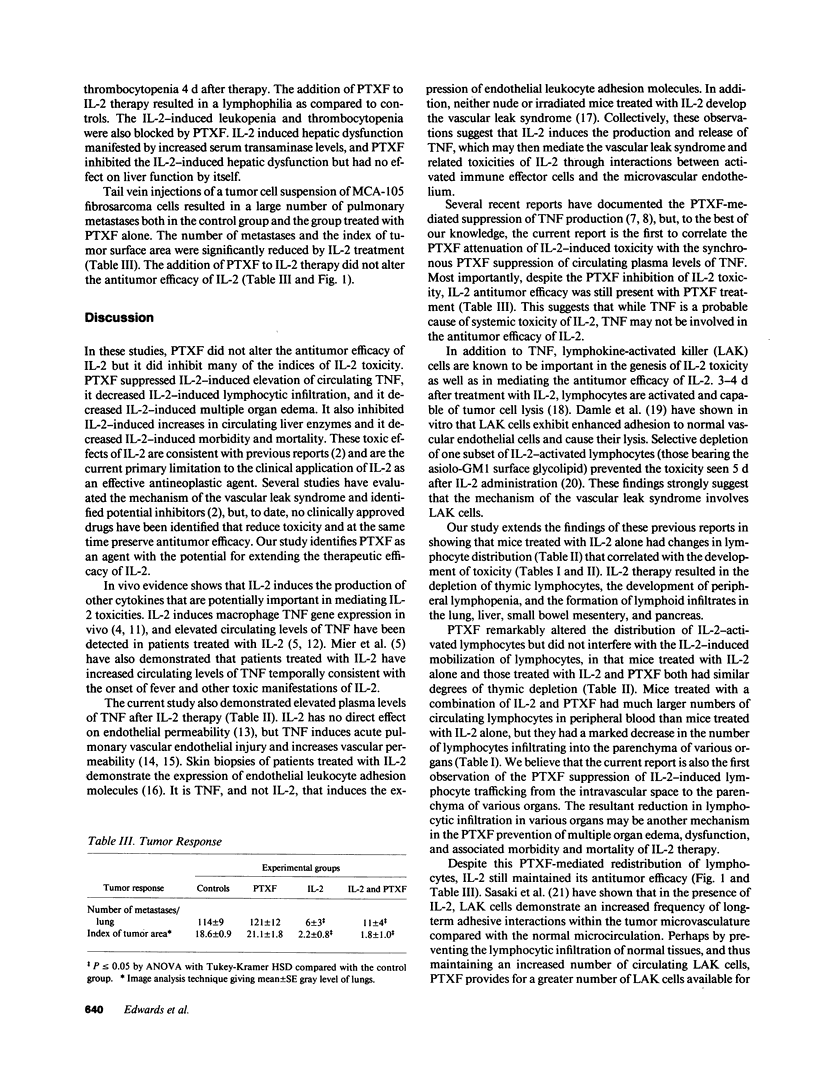
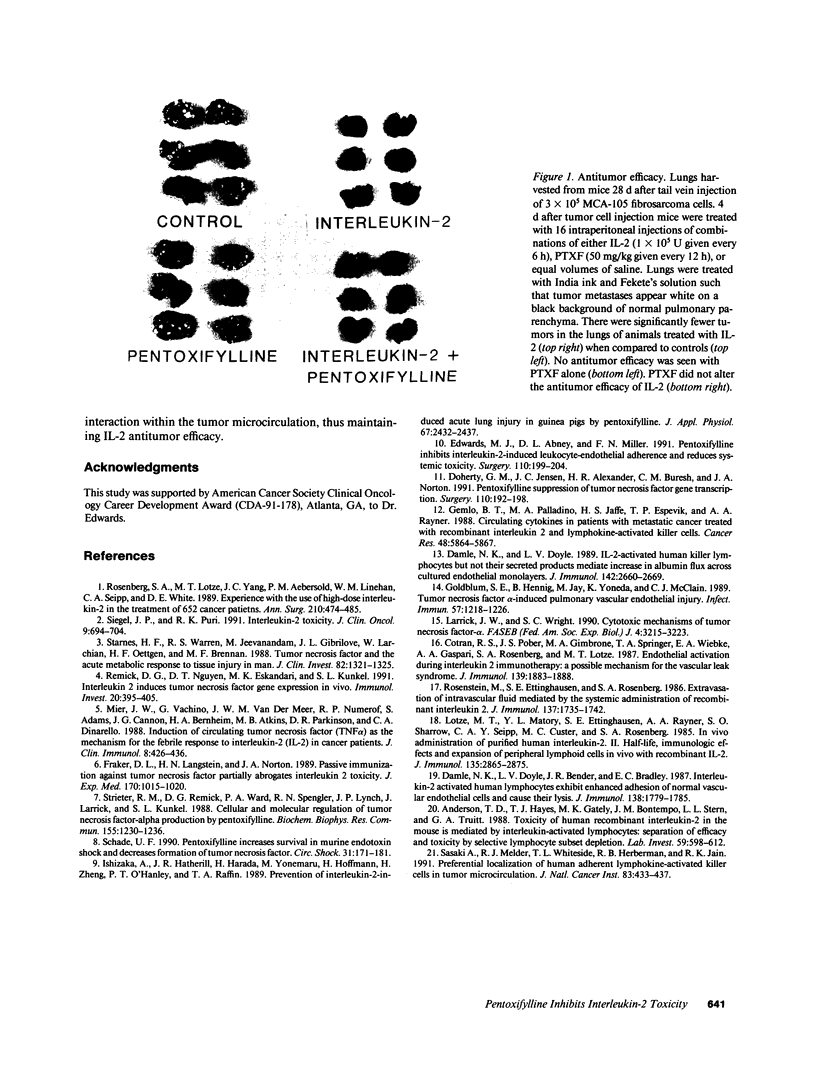
Images in this article
Selected References
These references are in PubMed. This may not be the complete list of references from this article.
- Anderson T. D., Hayes T. J., Gately M. K., Bontempo J. M., Stern L. L., Truitt G. A. Toxicity of human recombinant interleukin-2 in the mouse is mediated by interleukin-activated lymphocytes. Separation of efficacy and toxicity by selective lymphocyte subset depletion. Lab Invest. 1988 Nov;59(5):598–612. [PubMed] [Google Scholar]
- Damle N. K., Doyle L. V., Bender J. R., Bradley E. C. Interleukin 2-activated human lymphocytes exhibit enhanced adhesion to normal vascular endothelial cells and cause their lysis. J Immunol. 1987 Mar 15;138(6):1779–1785. [PubMed] [Google Scholar]
- Damle N. K., Doyle L. V. IL-2-activated human killer lymphocytes but not their secreted products mediate increase in albumin flux across cultured endothelial monolayers. Implications for vascular leak syndrome. J Immunol. 1989 Apr 15;142(8):2660–2669. [PubMed] [Google Scholar]
- Doherty G. M., Jensen J. C., Alexander H. R., Buresh C. M., Norton J. A. Pentoxifylline suppression of tumor necrosis factor gene transcription. Surgery. 1991 Aug;110(2):192–198. [PubMed] [Google Scholar]
- Edwards M. J., Abney D. L., Miller F. N. Pentoxifylline inhibits interleukin-2-induced leukocyte-endothelial adherence and reduces systemic toxicity. Surgery. 1991 Aug;110(2):199–204. [PubMed] [Google Scholar]
- Fraker D. L., Langstein H. N., Norton J. A. Passive immunization against tumor necrosis factor partially abrogates interleukin 2 toxicity. J Exp Med. 1989 Sep 1;170(3):1015–1020. doi: 10.1084/jem.170.3.1015. [DOI] [PMC free article] [PubMed] [Google Scholar]
- Gemlo B. T., Palladino M. A., Jr, Jaffe H. S., Espevik T. P., Rayner A. A. Circulating cytokines in patients with metastatic cancer treated with recombinant interleukin 2 and lymphokine-activated killer cells. Cancer Res. 1988 Oct 15;48(20):5864–5867. [PubMed] [Google Scholar]
- Goldblum S. E., Hennig B., Jay M., Yoneda K., McClain C. J. Tumor necrosis factor alpha-induced pulmonary vascular endothelial injury. Infect Immun. 1989 Apr;57(4):1218–1226. doi: 10.1128/iai.57.4.1218-1226.1989. [DOI] [PMC free article] [PubMed] [Google Scholar]
- Larrick J. W., Wright S. C. Cytotoxic mechanism of tumor necrosis factor-alpha. FASEB J. 1990 Nov;4(14):3215–3223. doi: 10.1096/fasebj.4.14.2172061. [DOI] [PubMed] [Google Scholar]
- Lotze M. T., Matory Y. L., Ettinghausen S. E., Rayner A. A., Sharrow S. O., Seipp C. A., Custer M. C., Rosenberg S. A. In vivo administration of purified human interleukin 2. II. Half life, immunologic effects, and expansion of peripheral lymphoid cells in vivo with recombinant IL 2. J Immunol. 1985 Oct;135(4):2865–2875. [PubMed] [Google Scholar]
- Mier J. W., Vachino G., van der Meer J. W., Numerof R. P., Adams S., Cannon J. G., Bernheim H. A., Atkins M. B., Parkinson D. R., Dinarello C. A. Induction of circulating tumor necrosis factor (TNF alpha) as the mechanism for the febrile response to interleukin-2 (IL-2) in cancer patients. J Clin Immunol. 1988 Nov;8(6):426–436. doi: 10.1007/BF00916947. [DOI] [PubMed] [Google Scholar]
- Remick D. G., Nguyen D. T., Eskandari M. K., Kunkel S. L. Interleukin 2 induces tumor necrosis factor gene expression in vivo. Immunol Invest. 1991 Jul;20(4):395–405. doi: 10.3109/08820139109057765. [DOI] [PubMed] [Google Scholar]
- Rosenberg S. A., Lotze M. T., Yang J. C., Aebersold P. M., Linehan W. M., Seipp C. A., White D. E. Experience with the use of high-dose interleukin-2 in the treatment of 652 cancer patients. Ann Surg. 1989 Oct;210(4):474–485. doi: 10.1097/00000658-198910000-00008. [DOI] [PMC free article] [PubMed] [Google Scholar]
- Rosenstein M., Ettinghausen S. E., Rosenberg S. A. Extravasation of intravascular fluid mediated by the systemic administration of recombinant interleukin 2. J Immunol. 1986 Sep 1;137(5):1735–1742. [PubMed] [Google Scholar]
- Sasaki A., Melder R. J., Whiteside T. L., Herberman R. B., Jain R. K. Preferential localization of human adherent lymphokine-activated killer cells in tumor microcirculation. J Natl Cancer Inst. 1991 Mar 20;83(6):433–437. doi: 10.1093/jnci/83.6.433. [DOI] [PubMed] [Google Scholar]
- Schade U. F. Pentoxifylline increases survival in murine endotoxin shock and decreases formation of tumor necrosis factor. Circ Shock. 1990 Jun;31(2):171–181. [PubMed] [Google Scholar]
- Siegel J. P., Puri R. K. Interleukin-2 toxicity. J Clin Oncol. 1991 Apr;9(4):694–704. doi: 10.1200/JCO.1991.9.4.694. [DOI] [PubMed] [Google Scholar]
- Starnes H. F., Jr, Warren R. S., Jeevanandam M., Gabrilove J. L., Larchian W., Oettgen H. F., Brennan M. F. Tumor necrosis factor and the acute metabolic response to tissue injury in man. J Clin Invest. 1988 Oct;82(4):1321–1325. doi: 10.1172/JCI113733. [DOI] [PMC free article] [PubMed] [Google Scholar]
- Strieter R. M., Remick D. G., Ward P. A., Spengler R. N., Lynch J. P., 3rd, Larrick J., Kunkel S. L. Cellular and molecular regulation of tumor necrosis factor-alpha production by pentoxifylline. Biochem Biophys Res Commun. 1988 Sep 30;155(3):1230–1236. doi: 10.1016/s0006-291x(88)81271-3. [DOI] [PubMed] [Google Scholar]



